Vergnano Tarot 1826-1851
Stefano Vergnano’s Tarot and playing card factory holds a special place in the history of the Tarot.
The Story of a Piedmontese Tarot
© Giordano Berti, historian of esotericism in art.
Article published by courtesy of the Author. Translation by Vic Berti.
Stefano Vergnano’s Tarot and playing card factory holds a special place in the history of the Tarot. In fact, it was even thanks to Vergnano that in Piedmont (Northwest of Italy), around 1826, a veritable “Golden Age” began for Piedmontese Tarot manufacturers.
The history of the Tarot in Piedmont was studied in depth some years ago by two respected scholars, Thierry Depaulis and Franco Pratesi. Both were responsible for the identification of the main individuals who in the eighteenth century moved from France to Piedmont to start local production of Tarot and playing cards.
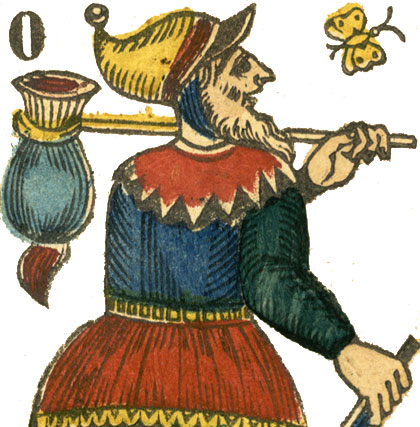
Above: The Fool chasing a butterfly from the Vergnano Tarot in the Piedmontese style, c.1835
A Crucial Step
The transition of Tarot cards from “Marseillais” to “Piedmontese” did not happen overnight, but was the result of an evolution whose steps are defined by specialists in two early prototypes: the “early Piedmontese Tarot” (substantially identical to Marseille), and the “early changed Piedmontese” (showing some characteristics of the new tradition).
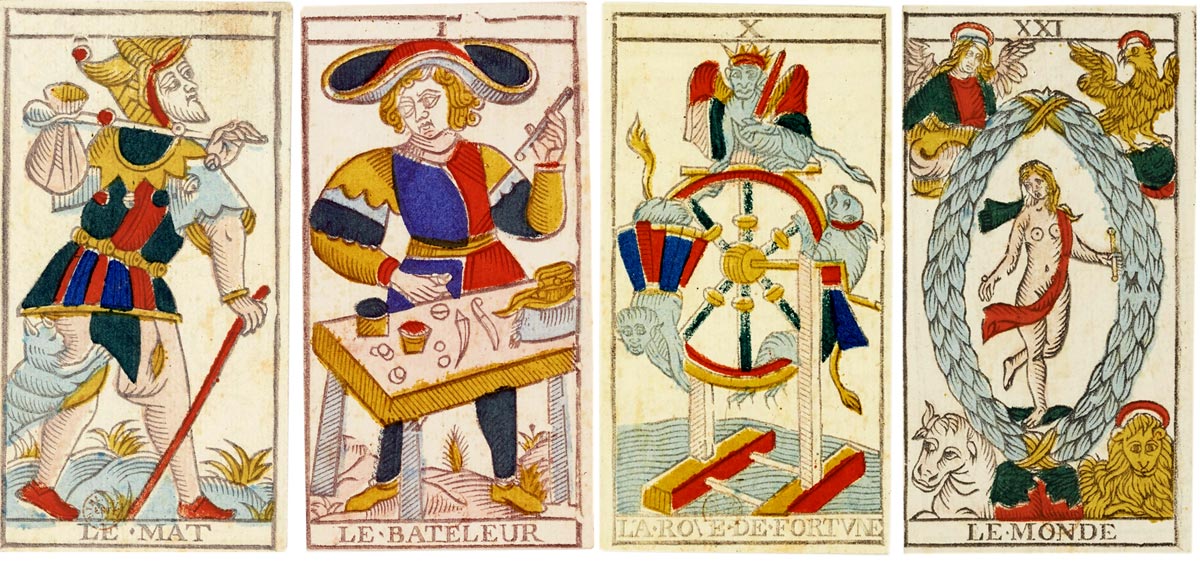
Above: standard “Marseillais” Tarot cards with inscriptions in French made by N. Conver (1809-1833). Bibliothèque Nationale de France.
Who were the pioneers of the new tradition? Among the most interesting documents, I discovered two quotes from the “Gazzetta Piemontese”. In 1826, this newspaper mentions the disassociation of two partners from the “Guglielmo Marengo and Co” playing card factory in Turin. The new company was registered to Stefano Vergnano. In 1828 the same newspaper mentions Giorgio e Stefano Vergnano (father and son), as manufacturers of “so-called castrated (i.e. some cards eliminated) Tarot and double-headed cards, at moderate prices”.
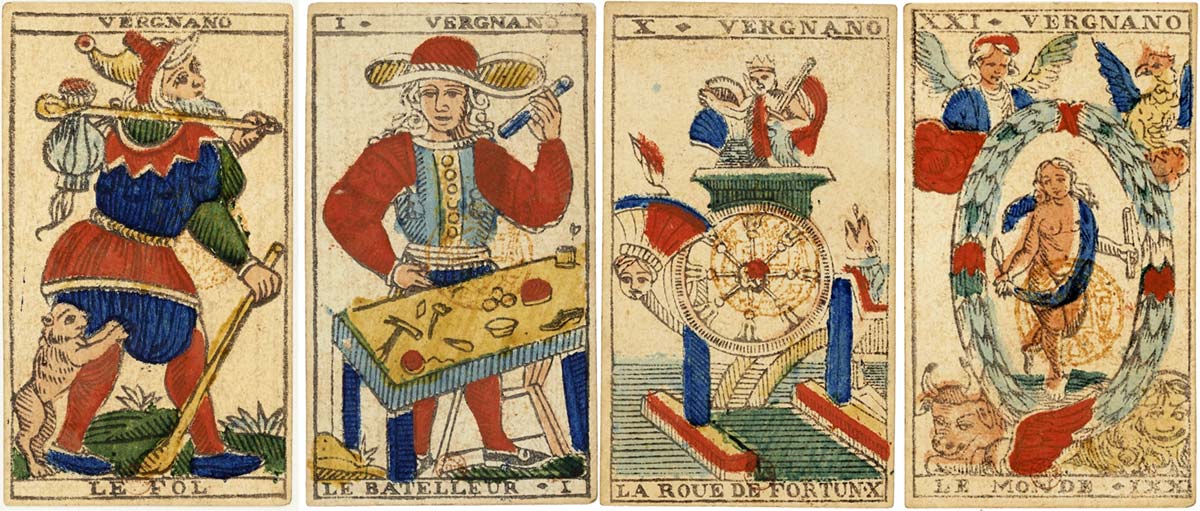
Above: early Piedmontese Tarot cards by Vergnano with French inscriptions, substantially identical to Marseille Tarot, c.1827. Bibliothèque Nationale de France.
Another interesting event dates from 1832. In that year Turin hosted the second Trade Fair of the Reign of Savoia. Both the factories of Guglielmo Marengo and Stefano Vergnano received an “honourable mention” by the Royal Chamber of Commerce for the quality of their decks. At the same time Giovan Battista Guala of Ghemme, another Piedmontese Tarot manufacturer, was also mentioned. It is doubtful that an award would have been bestowed to those tarot decks unless, when compared to their French counterparts, they showed some innovative design.
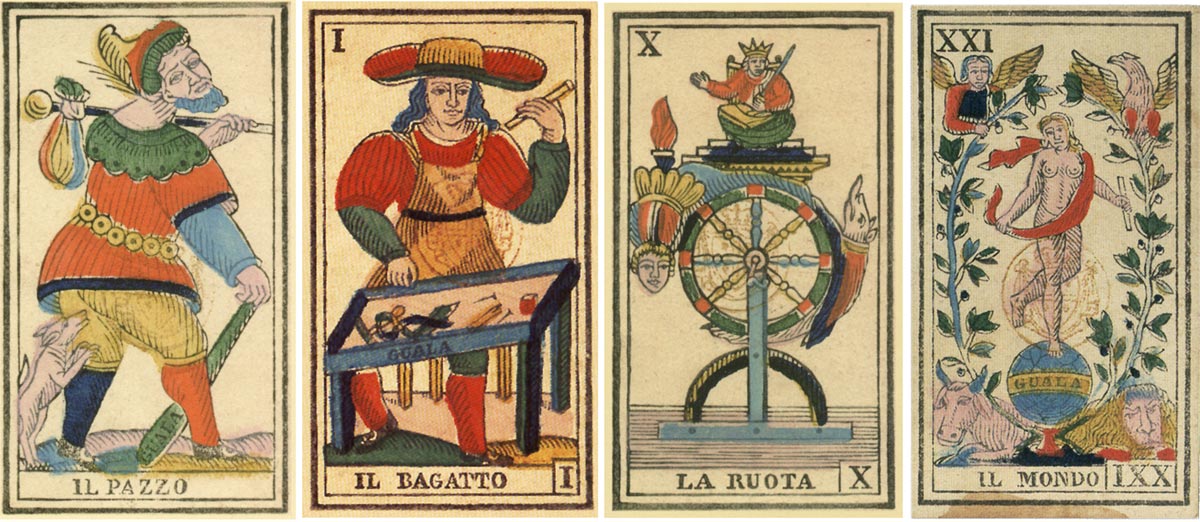
Above: early prototype Piedmontese Tarot cards by Giovan Battista Guala of Ghemme, with Italian inscriptions and Roman numerals. Bibliothèque Nationale de France.
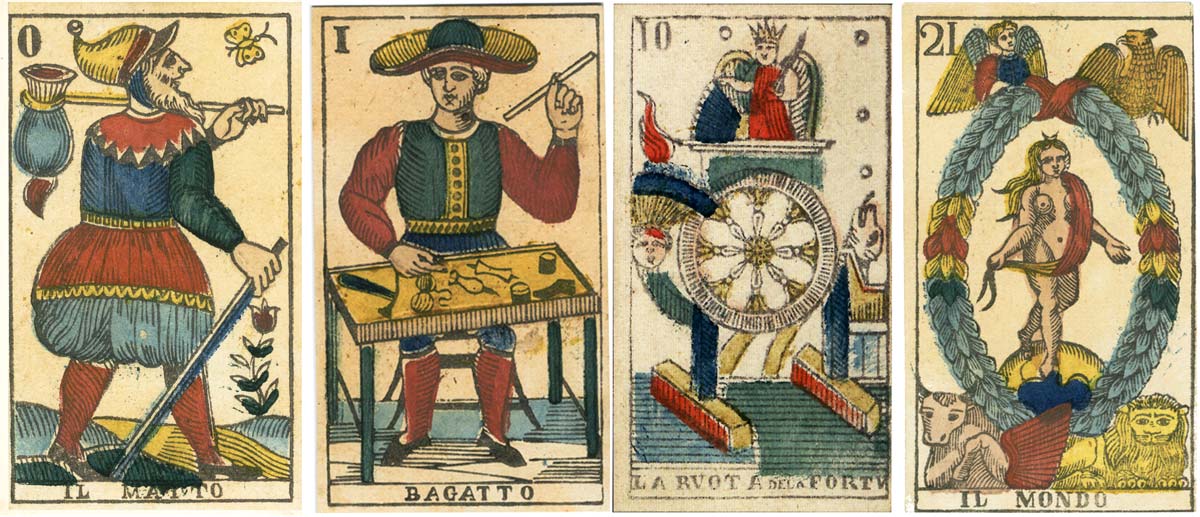
Above: early changed Piedmontese Tarot cards by Vergnano with Italian inscriptions and Arabic numerals, c.1835-45. The Fool chases a butterfly, instead of being chased by a dog. Bibliothèque Nationale de France.
A Trove of the Piedmontese Tarot
At this point a question arises: what were the Tarot images that Marengo and Vergnano produced? To discover this, we must examine those decks in public and private collections, and documents recently rediscovered by an Italian researcher, Nicola De Giorgio, at the Academy of Sciences of Turin. The Academy is a “treasure-trove” that preserves the Tarot history in the Kingdom of Savoy before the unification of Italy.
To this day the Academy holds many uncut sheets printed with woodcut technique which, by Royal Decree, had to be lodged by the manufacturers at the Royal Offices of Commerce. These sheets are the earliest evidence relating to the birth of the authentic Piedmontese tradition of Tarot.
Unfortunately, some sheets have been lost, so we cannot have a detailed view of the iconographic evolution. However we can say that, in general terms, that the factory of Guglielmo Marengo produced, since the early nineteenth century, the “early” piedmontese Tarot cards (ie: almost identical to those of Marseilles, with captions in French). But between 1826 and 1832 Stefano Vergnano deposited an innovative model (called “an early changed Piedmontese”) which was used - with some variations - in the following decades.
I shall not describe all the peculiarities of the Vergnano Tarot. It is sufficient to say that as well as captions in Italian, Arabic numerals instead of Roman, and new drawings of many Court cards, Vergnano introduced a totally new image: The Fool chasing a butterfly, instead of being chased by a dog or wild cat. Also, The Ace of Cups is a large jar filled with fruits and flowers. The Knight of Coins has an Arabic hat. The Knight of Swords has a Hussar helmet.
According to Franco Pratesi, the Vergnano factory went out of business around 1851, as demonstrated by some documents kept at the Archivio di Stato of Turin. The last Tarot produced by Vergnano was not an original design, but a review of the masterpiece engraved in Milan by Carlo Dellarocca for the printer Ferdinando Gumppenberg.
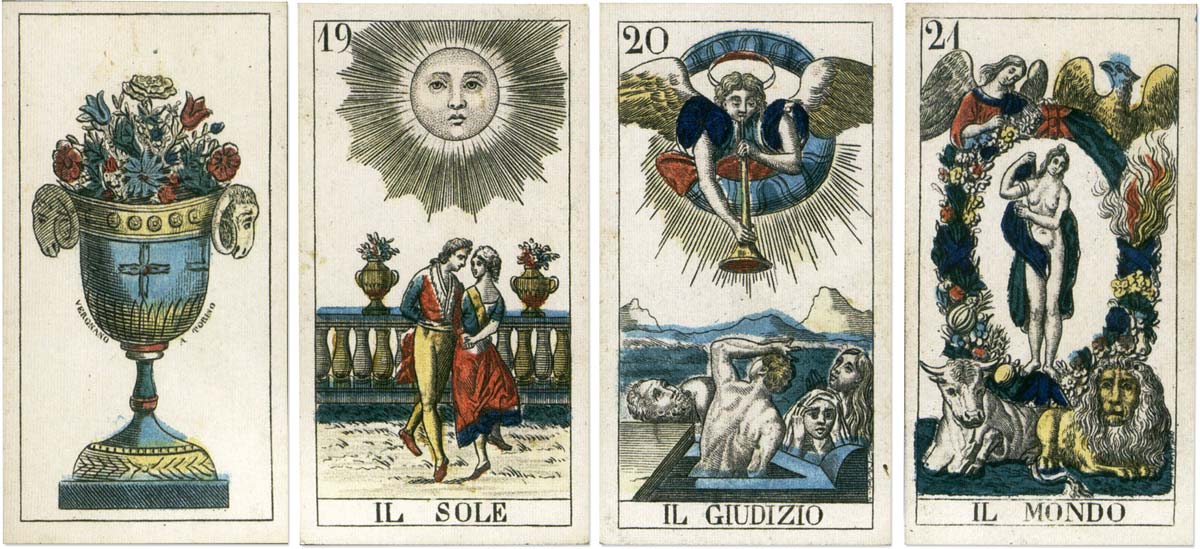
Above: Tarot cards produced by Vergnano based on model by Carlo Dellarocca, c.1850. The inscription on the ace of cups reads: "Vergnano a Torino".
A Precious Reprint
In 2014 I personally supervised the faithful reprint of a Stefano Vergnano Tarot deck dated around 1845-50, but clearly based on a model made around the 1830. This reprint gives to all Tarot lovers of today the opportunity to observe in detail the features of the first true Piedmontese Tarot, and to highlight similarities and differences with “Marseilles” decks.
The “Vergnano Tarot 1830” was published by Araba Fenice in collaboration with Renaissance - Italian Style Art. It is a limited edition of 500 copies, numbered and signed by the editor, Giordano Berti, who is also the author of the historical booklet that accompanies the deck, available in Italian, English and Portuguese. The deck and booklet come in a wonderful book-shaped presentation box- created by art designer Letizia Rivetti.
WEBSITE: VERGNANO TAROT 1830►

Above: Stefano Vergnano Tarot reprint, 2015, available here►
BIBLIOGRAPHY & CREDITS
Berti, Giordano: Old Italian Tarot. 78 cards engraved by Stefano Vergnano, Turin c.1830, Araba Fenice, Boves 2015
Depaulis, Thierry: Antichi Tarocchi Liguri-piemontesi, Lo Scarabeo, Torino 1995, p. 8-22
Pratesi, Franco: Documents on Playing-Cards in Piedmont, The Playing-Card, 25 (1997) p. 122-135, p. 166-175.
De Giorgio, Nicola: I Tarocchi nel Regno Sabaudo, dal 1815 all'Unità d'Italia (part 1), The Playing-Card, 42.3 (2014) p. 163-191.
De Giorgio, Nicola: I Tarocchi nel Regno Sabaudo, dal 1815 all'Unità d'Italia (part 2), The Playing-Card, 42.4 (2014) p. 237-258.
Illustrations of cards by Conver 1809-1833, Giovan Battista Guala and Vergnano c.1827 are from the Bibliothèque Nationale de France.

By Simon Wintle
Member since February 01, 1996
Founder and editor of the World of Playing Cards since 1996. He is a former committee member of the IPCS and was graphics editor of The Playing-Card journal for many years. He has lived at various times in Chile, England and Wales and is currently living in Extremadura, Spain. Simon's first limited edition pack of playing cards was a replica of a seventeenth century traditional English pack, which he produced from woodblocks and stencils.
Related Articles

Tarot Actuel 1984
Major arcana to cut out, issued with the French magazine Actuel, using photographic images.

Lyon pattern made in Italy by Pietro de Santi
The Lyon pattern was initially developed in France during the 16th century. As Lyon was a trading hu...

Mountain Dream Tarot
Groundbreaking Tarot created by Bea Nettles, using photographs and photo montage.

Laurenzo Propagine
Spanish-suited cards made in Italy by Laurenzo Propagine.

Il Tarocco Mitologico
Fully pictorial Tarot designed by Amerigo Folchi with figures mainly from Greek mythology.

Neapolitan pattern by Luigi Pignalosa, Naples
Two versions of the Neapolitan pattern from the British Museum by Luigi Pignalosa, Naples, 1875 & 18...

The Millenium Tarot: Tarot of the Four Worlds
First Australian Tarot, designed by Mary Susan Chamberlain, with artwork by Ziba Vilmanis-Westenberg...

Motherpeace Round Tarot
An original and imaginative feminist tarot based on Goddess energy.

Jeu de Tarot (Catel & Farcy)
Colourful version of a standard French (‘Bourgeois’) Tarot.

Dylan Dog
Characters and objects from the Italian comic book series Dylan Dog, written by Tiziano Sciavi and d...

Royal Britain
Pack devised by Pietro Alligo depicting English monarchs from Alfred the Great to Elizabeth II.

Paris 2024 Olympics 2
A standard French Tarot game pack with passing references to the Paris 2024 Summer Olympic Games.

Tarot – Images du Pays Basque
Seventy-eight photographic images of the French Basque Country on a pack for playing the game of Tar...

A Million Dollar Tarot: The Alleyman’s Tarot
The Alleyman’s Tarot successfully raised $1,404,172 on Kickstarter. This unique 133-card deck includ...

Quên Tarot
A mystical voyage of love and self-discovery created by Duy Khánh Võ.

Le Monde Primitif Tarot
Facsimile edition produced by Morena Poltronieri & Ernesto Fazioli of Museo Internazionale dei Taroc...
Trending Articles
Popular articles from the past 28 days


